
|
COLORING PAGES |
|
The book is available for download on your iPhone, iPad, iPod touch, any other e-book readers and on your computer. |
|
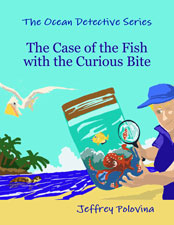
$0.99 |
Alexis is an Ocean Detective Agent. One day, Jake, a fisherman, visited her with a fine tuna with several circular shallow holes. Alexis starts her investigation to find out what has happened to the tuna. She asks her friend Hector the dolphin. Surprisingly, Hector says that he has the same experience that something has made a nasty bite and left a hole on his body just like the one on the tuna. It seems the mysterious creature is hiding somewhere close in the sea. What kind of creature is responsible for those nasty bites? Alexis goes to the ocean to find out. What will she encounter and can she solve this mystery? |
|
|
|
Jack the Lizard is on YouTube |
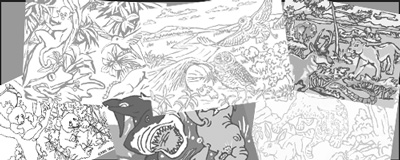
Animal Coloring Pages are HERE!! |
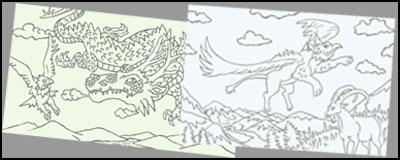
Animals in Legend Coloring Pages are HERE!! |
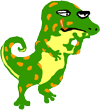
|
For the print size image, click |
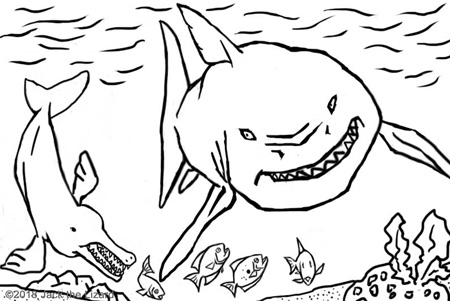
|
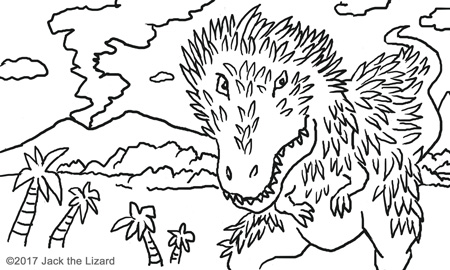
|
|
|
Megalodon and Squalodon Megalodon emerged after dinosaurs had been extinct. Many mammal species also evolved during Miocene Epoch. In the Ocean cetaceans such as whales and dolphins appeared, as did land mammals such as horses, dogs, and bears during the Miocene. Megtalodon hunted cetacean including squalodon and sperm whales. Although Megalodon were at the apex of the food chain, there were competitors such as Livyatan and killer whales. Livyatan was similar to a sperm whale, but the size was almost as large as Megalodon and the teeth were much stronger than modern one. Megalodon probably inhabited in warm seas, but they could have adapted to cold sea water. |
True Colors of Feathers Although the feathered dinosaurs have been found many, most of them have not used their feathers for flying. It is suggested that the function of feathers is display or regulating their body temperature. The display hypothesis is backed up with which fossilized feather included pigments. Also since most of feathered dinosaurs are theropoda which usually have accurate eye sight, they might be able to distinguish colors. The Early Cretaceous Period it was colder than the Late and some of dinosaurs were probably adapted to cold climate. However it is still unknown that the exact faculty of feathers for dinosaurs. |
|
For the print size image, click |

|
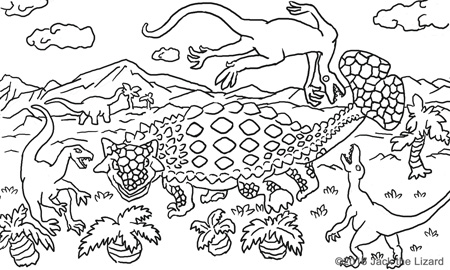
|
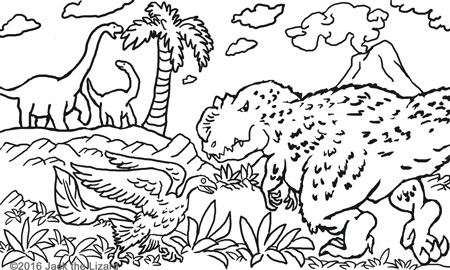
|
|
|
Impulse of Tail club - Ankylosaurus - Ankylosaurus had lived in the Late Cretaceous Period (68 million years ago). They belong to the member of the Thyreophora or the dinosaurs with armor. Some of them also have huge club on their tail. As they grow to adult, the club also gets large and hard enough to be used as weapon. The club could produce the impact of breaking the bones of theropoda like Troodon. Also Ankylosaurus might use it while they fight each other. Although the size is about 7 m (24 ft), Tyrannosaurus would not approach to the Ankylosaurus without caution. |
Feathered Carnivorous Dino Yutyrannus belongs to the group of Tyrannosaurs. The fossils were found in Liaoning Province of China in which the numbers of feathered dinosaurs were found. Yutyrannus lived during the early Cretaceous period, around 125 million years ago. On the other hand Tyrannosaurs rex existed late Cretaceous period about 68 million years ago, so Yutyrannus has different body features from T.Rex. For example Yutyrannus has three fingers on its forelimb instead of two. The fossils also indicated that Yutyrannus had feathers on its body. Yutyrannus was a robust meat-eating dinosaur, about 9m (10ft) long, therefore feathers were not for flying or gliding. The function of feathers is perhaps protection from cold weather. The early Cretaceous had colder climate than the late. ab was also a threat to eggs, while dodo birds ate them for snack. |

|
For the print size image, click |
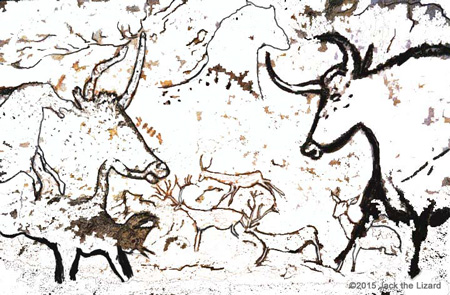
|
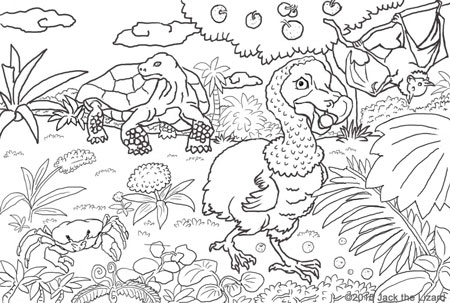
|
|
|
Art of Cave - Lascaux Cave painting - Cave paintings are images that prehistoric human depicted animals and abstract forms on walls and ceiling of caves. Oldest painting which is about 40,000 years old is found on the island of Sulawesi in Indonesia last year. Mineral pigments were applied to the images of cave paintings and some of them were depicted by incising into the stone directly. Lascaux cave painting found in southern France is one of the most famous cave paintings. There are about 900 images of animals and 600 of them were precisely identified. Paintings are about 17,000 years old and consisted of bulls, deer, cats, bears and humans. Since many fossils of depicted animals were also found in the area surround the cave, those animals probably inhabited in that area at the time of images were created. The Great Hall of Bulls is the most popular images among Lascaux cave paintings. The image of Aurochs is the ancient of domestic cattle is found in this hall. |
Paradise lost - Dodo Bird - Dodo birds used to live in the island of Mauritius, but they had become extinct during the 17 century. Most probable cause of their extinction is over hunting by humans. From the remains of dodo birds, it was inferred that they had no flying ability even though they had wings. At the time dodo birds thrived in Mauritius had no predator to eat dodo birds. No needs to fly away or run away first for dodo birds. All of a sudden humans had come to this paradise and newcomers were not friendly to dodo birds at all. Dodo birds might have not had fear against humans and been easily caught without chasing them. Supposedly, in the forest dodo birds walked around looking for food on the ground. The main diets of dodo birds were perhaps nutritious fallen fruits and nuts. On the assumption that they had a clutch of eggs on the ground, human introduced―predators such as cats and dogs had easy access to their eggs. The Land crab was also a threat to eggs, while dodo birds ate them for snack. Before human settlement the island of Mauritius had many endemic species such saddle-backed Mauritius giant tortoise and Mauritian flying fox, but they gone extinct. Still Mauritius is a beautiful island which located in Indian Ocean, close to the island of Madagascar. |
|
For the print size image, click |

|
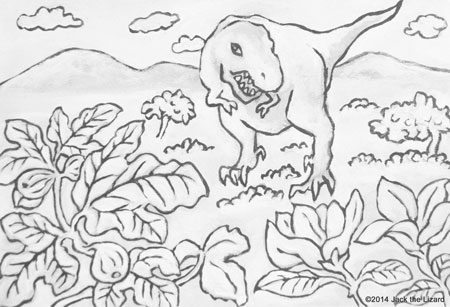
|
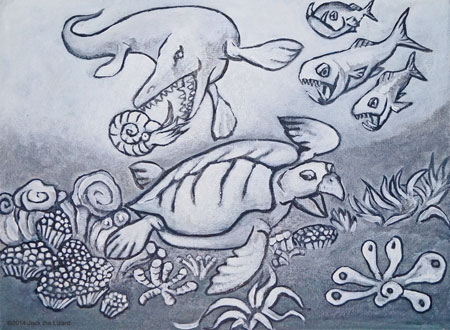
|
|
|
Flower Changed the World Flowering plants or angiosperms had begun to appear during the Cretaceous Period, around 140 million years ago. Since then they had proliferated rapidly. Modern tree species such as the magnolia and the common fig emerged in this period. Although the ancestor of flowering plants is unknown, they might have evolved gradually from the relative of seed—producing plants without flower, such as ferns. Although bees had not evolved yet, flowers attracted insects such as beetles and butterflies. Then flowering plants provided food such as pollen and nectar for insects to make sure that insects carried pollen from flower to flower. In this way both flowering plants and insects had thrived. Until then plants without flower or gymnosperm plants had nothing but wind and water to spread their pollen. In the Late Cretaceous Flowering plants overwhelmed non-flowering plants. Dinosaurs had coexisted with flowering plants. However it is not certain that dinosaurs get benefit from flowering plants as insects and mammals did, because mammals were the biggest rivals of dinosaurs. As flowering plants propagated themselves, small mammals also increase their number and large mammals by which small dinosaurs were eaten also appeared on the Earth. |
Giant Sea Turtle Ever - Archelon - Archelon lived in the Western Interior Seaway by which the continent of North America was divided during the Late Cretaceous Period, around 75 to 80.5 million years ago. Archelon had approximately 13ft (4m) long body with large flippers. Modern-day Leatherback sea turtle is closest relative of Archelon. Like a leatherback sea turtle Archelon did not have scales instead a frame work with bone covered by a leathery carapace. Archelon probably fed on squids and another mollusks drifting near the sea surface. In the Western Interior Seaway many predators such as mosasaurus and squlicorax (large shark) probably swimming next to an Archelon. However with its powerful flippers and size help an Archelon to escape from those predators. |

|
For the print size image, click |
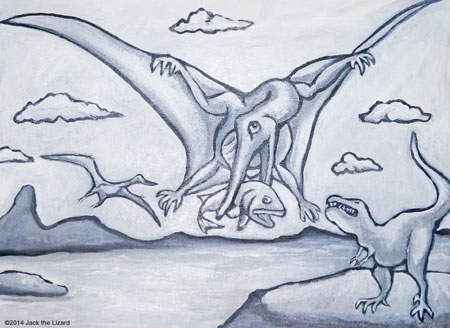
|
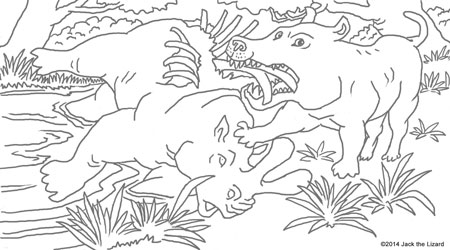
|
|
|
Certainly the size is impressive - Quetzalcoatlus - Quetzalcoatlus was probably one of the largest flying reptiles of all time. They lived during the Late Cretaceous Period in North America. While their wingspan was about 30 feet (10m), they were probably gliding rather than flying with it. Despite several specimens were found in Texas, the lifestyle of Quetzalcoatlus is still not clear. Even the idea that Quetzalcoatlus is totally terrestrial animal is proposed in spite of their huge wings. One theory suggested that Quetzalcoatlus was a scavenger, not a fish eater because their fossil site was far from coastline or there were not the lake or rivers nearby at the time they still exited. However another theory supports fish eating lifestyle because their beaks and jaws adapted to sweep fish while they fly. |
Huge Skull tells Story - Andrewsarchus - Andrewsarchus could be the largest land carnivore ever lived on the Earth. The epoch in which Andrewsarchus lived was the Late Eocene from 45 to 36 million years ago. Since we have discovered the skull of Andrewsarchus only, it is difficult to estimate its exact size. However the massive size of the skull tells us that Andrewsarchus might be reached over 11 ft (3.4 m) long and weigh over 2200 lb (1000 kg). It is not determined whether Andrewsarchus was an agile predator or a robust scavenger. Besides the jaws were probably the strongest in land mammals of their time and able to crush large bones easily. From the form of their teeth Andrewsarchus might have eaten plants as well. So it might be possible that Andrewsarchus was an omnivore. Brontotheres also lived in Asia during the Eocene around 56 - 34 million years ago. Contrary to their appearance, Brontotheres more closely related to horses rather than rhinoceros. |
|
For the print size image, click |

|
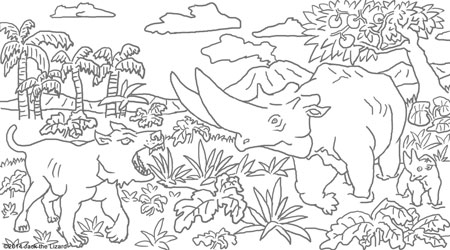
|
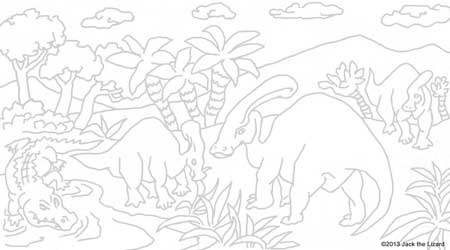
|
|
|
Dawn of Carnivore Arsinoitherium lived in northern Africa during the late Eocene and the early Oligocene around 36 to 30 million years ago. Although the appearance is similar to rhinoceros, arsinoitherium are related to elephants and hyraxes whose feet have five toes. The habitat was likely tropical rainforest in which desirable plants were available for them. Creodonts were a group of carnivorous mammals that lived from 55 million to 35 million years ago. As land predator they had successfully expanded over worldwide. The range was Africa, Eurasia, and North America. Hyaenodontidae was the most successful family in the group of Creodonts. The size of Hyaenodontidae was varied from only 5 kg to 500 kg in weight. Probably they had played vital role in each ecosystem they had lived as predator till the end of Miocene. Large ones probably hunt alone large prey such as arsinoitherium while smaller ones hunt together as modern wolves. Although Hyaenodontidae have sharp teeth for slicing meat and powerful jaws to crush bones as hyenas and lions do now, they are not related to those modern carnivores. |
Alien Head - Parasaurolophus - Parasaurolophus lived during the Late Cretaceous Period, about 76-73 million years ago. Three species of Parasaurolophus are known and remains of them are found in Canada and U.S. The head of Parasaurolophus looks like that of “Alien” from popular movie. The exact function of the long crest is not known. Parasaurolophus was able to stand on two legs, but probably usually walk on four. The estimated size was approximately 33 ft (10 m) and the weight was about 7700 lb (3.5 tons). Parasaurolophus probably lived in herd and grazed on plants. Although they were land animals, they stay close to body of water such as rivers and swamps. Also they might migrate for their nesting place. |

|
For the print size image, click |
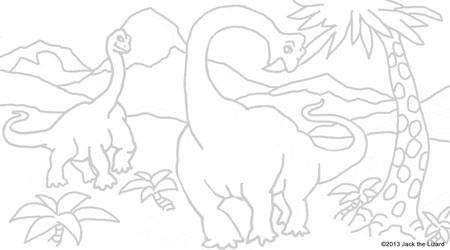
|
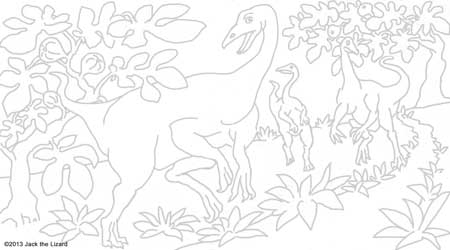
|
|
|
High browser - Brachiosaurus - Brachiosaurus lived during the Late Jurassic Period, about 150 million years ago. The fossils are found in U.S.A. and Tanzania. Unlike most sauropods the forelimbs of Brachiosaurus are longer than its hindlimbs. The size is approximately 85ft (25m) in length and Brachiosaurus could reach the plants over 30ft (9m) high. The fossils were discovered from the Morrison Formation of which the environment was floodplain and it had the wet and dry season. The plants that Brachiosaurus likely had eaten were ginkgos, tree ferns and conifers. In contrast to reptile Brachiosaurus was warm-blooded animal, so it could produce heat inside its body. |
Ornithomimus was not a bird Ornithomimus lived during the Late Cretaceous Period, around 75—65 million years ago. Species of Ornithomimus look like ostriches, but they are not related to birds. Since they were bipedal dinosaurs, they lived on land and could run fast. The fossils of Ornithomimus were found in North America. They had beak without tooth and long arms. They might have eaten insects, fruits, leaves and small animals such as lizards and mammals. In contrast to the Jurassic Period numbers of flowering plant species (anigosperms) spread over land by the Late Cretaceous Period and previously dominated species such as ferns and conifers were replaced by flowering plants. |

|
For the print size image, click |
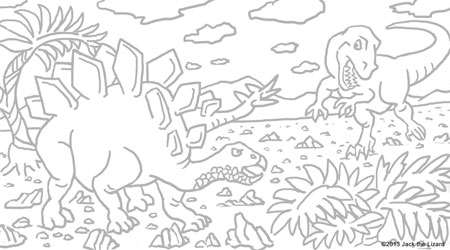
|

|
|
|
Dinosaurs with Plates and Spikes - Stegosaurus - Stegosaurus lived during the Late Jurassic Period, around 155 to 150 million years ago.Their remains are found in North America and Europe. They were herbivores who chewed plants and might have stored food in their cheeks. The size of Stegosaurus is approximately 30ft (9m) in length and weighs about 5tons.Despite their large body they had relatively small brain, about the size of dogs’. That does not suggest they are not intelligent animal though. Predators such as Allosaurus and Ceratosaurus also lived same period of time and regions as stegosaurus did. Stegosaurus probably defended themselves against those carnivorous dinosaurs with the spikes on their tails. It is not clear whether the plates were functioned as amore or not. Although many of stegosaurus bones are found in North America, their ancestors are probably from Asia. Many of dinosaurs who had plates and spikes like stegosaurus did exist in China long before stegosaurus emerged. |
Everybody knows Triceratops Two species of triceratops are recognized now, Triceratops horridus and T. prorsus. Triceratops is the largest frilled dinosaur, about 30ft (9m) long and 26000lb (12 tonnes) in weight. They lived in North America during the late Cretaceous Period around 65 to 68 million years ago. We did not know whether they were solitary animal or living in herds. Since they were herbivores, they probably had been gazing low growing plants for most of their day, as rhinoceros do today. |
|
For the print size image, click |

|
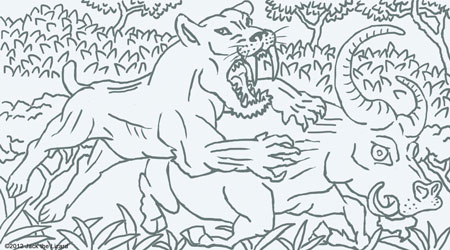
Another coloring of Smilodon, Click HERE!!
|
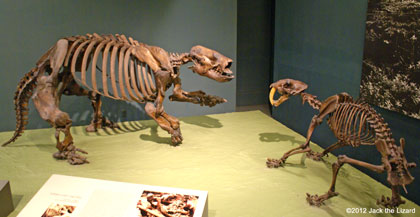
|
|
|
Smilodon prey on American Bison Smilodon belongs to the group of machairodonts which is one of the saber-toothed cat family. Three species of Smilodon are known today, Smilodon gracilis, Smilodon fatalis, and Smilodon populator. Smilodon gracilis is the oldest and smallest species. Smilodon gracilis which lived in North America from 2.5 million to 500,000 years ago weighed about 120 to 220lb (55 to 100kg). Smilodon fatalis lived in North America from 1million to 100,000 years ago. After the Great American Interchange they prevailed into South America. Their weight range could be around 350 to 620lb (160 to 280kg). Smilodon populator is the largest species of all, about 490 to 790lb (220 to 360kg) in weight and 100in (2.6m) long. From 1 million to 10,000 years ago Smilodon existed in South America as one of the top predator at that time. Smilodons had very robust body like bear. Therefore they probably ambush their prey instead of chasing. Then they put their prey under control with their powerful forelimbs. They could break the neck of their prey or thrust their saber teeth into flesh to finish their victim. Smilodon’s upper jaw is adapted to open wide. So they could use their serrated long teeth efficiently. The preys of Smilodons were probably large animals such as bison, deer, American camels, horses, and ground sloths. They could hunt games lager than themselves. But diminishing large prey might contribute to the cause of Smilodon’s extinction. |
||

|
For the print size image, click |
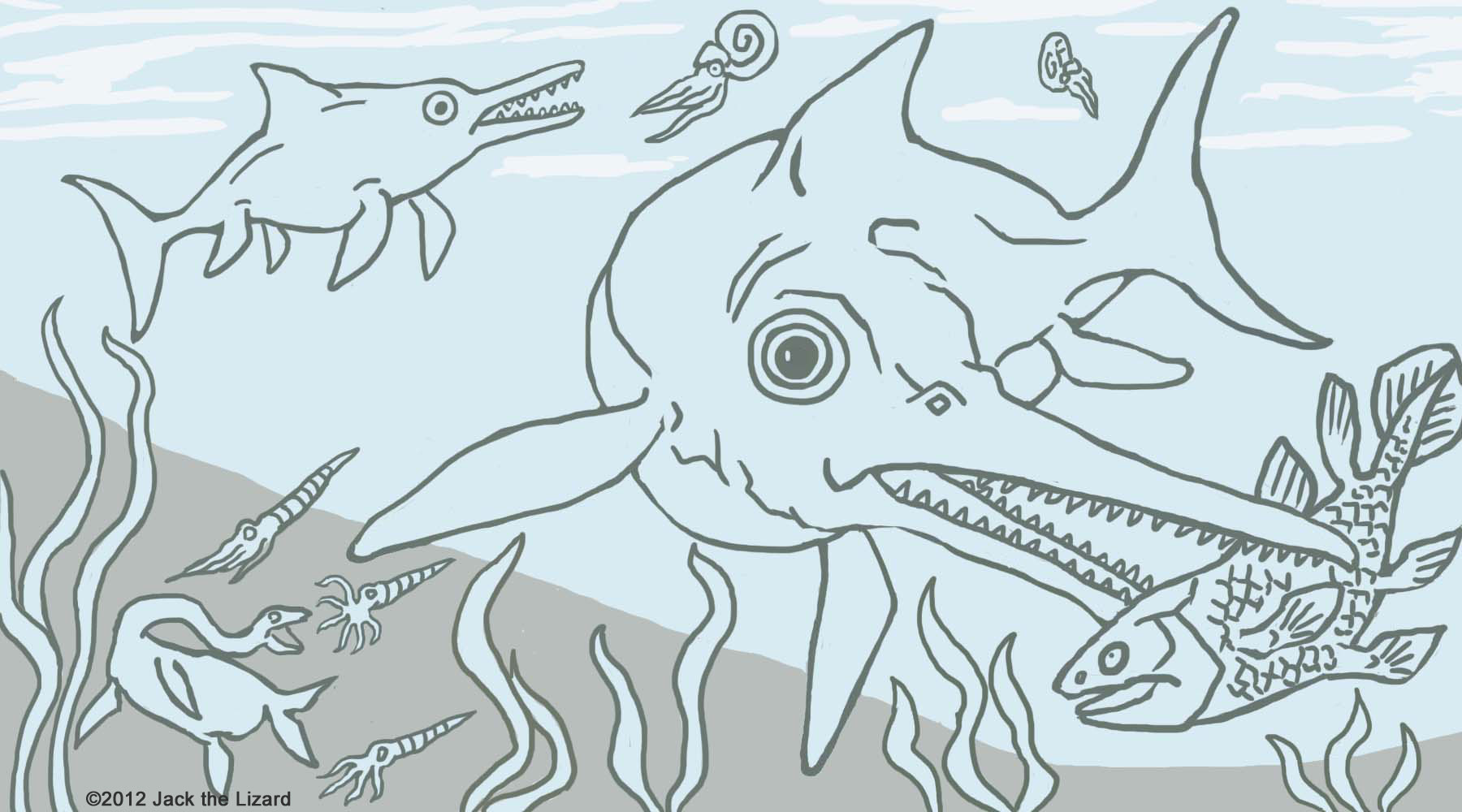
|
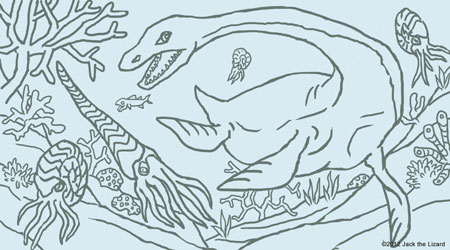
|
|
|
Reptile goes to the Sea - Ichthyosaurus - The ancestor of Ichthyosaurus had appeared around the Middle of the Triassic Period. Since then the group of ichthyosaurus diversified their species and they had heyday during the Jurassic Period. Although they were highly adapted to the marine life, they became extinct during the Late Cretaceous Period. The preys for Ichthyosaurus were probably fish and cephalopods such as belemnites and ammonites. The distinguished features of Ichthyosaurus are unusually large eyes and long mouth. Ichthyosaurus could have hunt prey in the dim water or during the night with those eyes. When the large predator such as plesiosaurus and mosasaurus gained power in the sea, Ichthyosaurus might have lost the competition for prey. |
Long Neck is the Symbol - Elasmosaurus - Elasmosaurus was a member of plesiosaurus group that lived during the Late Cretaceous Period about 80 million years ago. The habitat of Elasmosaurus is the shallow sea, called the Western Interior Seaway that had vertically run through the middle of North America. Elasmosaurus probably prey on cephalopod such as ammonites and belemnites. The bony fish was also meal for Elasmosaurus. Some stones are found from the stomach of Elasmosaurus. Those stones could have helped Elasmosaurus to digest food. The size of Elasmosaurus was about 46ft (14m) long. Elasmosaurus probably swim slowly. The long neck of Elasmosaurus was useful for sudden strike the prey from long distance instead of chasing them. |
|
For the print size image, click |

|
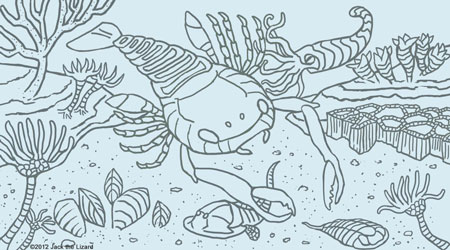
|
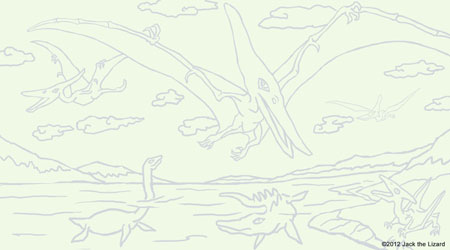
|
|
|
Paleozoic dominator - Sea Scorpion - Eurypterids are called “Sea Scorpion”. They appeared in Ordovician Period about 460 million years ago and disappeared during the Permian-Triassic extinction event approximately 251 million years ago. Early sea scorpions lived in warm shallow sea water, but later ones changed their habitat from sea to brackish or freshwater region. Some of them even spent their time on the land from time to time. The sea scorpions varied in size from only 8in (20cm) up to 8ft (2.5m). The largest one is Jaekelopterus of which claws are about 18in (46cm) long. They probably had caught fish and other arthropods. The picture is the scene of shallow water life in the Late Silurian. Extinct coral “Halysites” grow right and the Oncocerid (the relative of nautilus) swim above it. Clam like brachiopods also cluster under the crinoids at the left hand side. Sea scorpion is Acutiramus, about 2m long. |
Flying Lizard - Pteranodon - Pterosaurs were the first flying vertebrates. Although their ancestor is not known yet, these flying reptiles had evolved since the late Triassic Period. They said good-bye to the Earth, at least as their living form, during the late Cretaceous period. Pterosaurs are not Dinosaurs, whereas both of Dinosaurs and Pterosaurs are members of the Archosaurs which includes birds and crocodilians as well. Pteranodon belong to Pterosaurs group. Pteranodon was probably living by the ocean and fishing in their ordinary life during the late Cretaceous Period. |
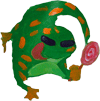
|
For the print size image, click |
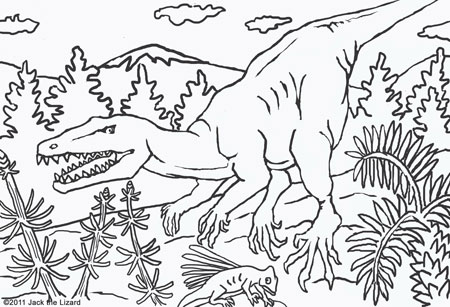
|
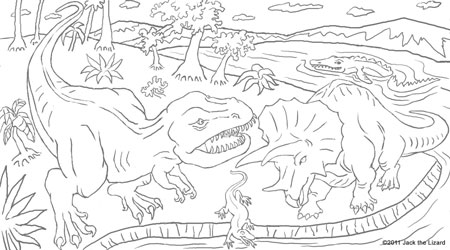
|
|
|
Herrerasaurus stand on two legs Herrerasaurus lived during the Triassic period, about 230 million years ago. The fossils were found in northwest Argentina. Herrerasaurus is probably one of the oldest theropod dinosaurs. Theropod dinosaurs were bipedal and mostly meat eater. Tyrannosaurus was one of the typical theropod dinosaurs, but Herrerasaurus was much smaller, about 10 to 13ft (3 to 4m) long. Neocalamites were Triassic horsetails. Horsetails are one of the fern families, but Neocalamites were much larger than modern horsetails. Three Neocalamites are growing tall at the front left side. Longisquama was about 6in (15cm) long, shape like lizard. The function of long scales is unknown. Some think that Longisquama was related to the origin of bird. The relatives of Cycads exist at least about 300 million years ago. |
Triceratops face off Tyrannosaurus might have eaten Triceratops. The hipbone of one Triceratops has bite marks of Tyrannosaur. This might suggest that Tyrannosaur scavenged on dead triceratops or bit meat out of live triceratops. In addition that one horn of triceratops has the trace of recovering from the wounds made by Tyrannosaur. This confrontation probably occurred during the Late Cretaceous period in North America. Lizards (squamata) already existed in North America in this period. One of them is Palaeosaniwa, about 6ft (180cm) long, which was a meat-eating lizard. Palaeosaniwa was perhaps venomous and closely related to Gila monsters. So far the oldest lizard fossil in the world was found in Japan, which is about 130 million years old. This lizard, about 10in (25cm) long, probably ate plants. Mosasaurus are also lizards but they lived in the ocean, so they are marine lizards. Unfortunately the family of Mosasaurus was extinct. |
|
For the print size image, click |
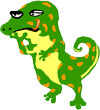
|
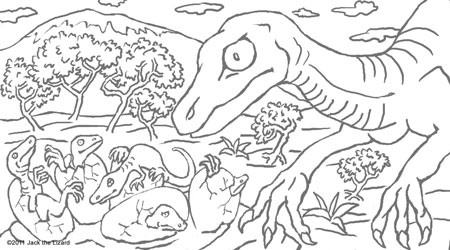
|
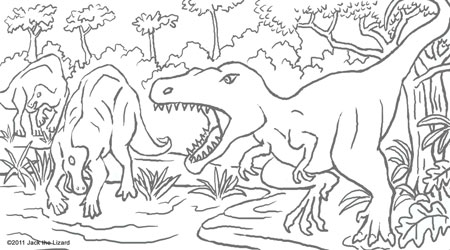
|
|
|
Caring father - Troodon eggs - Troodon was bird-like dinosaur, so it laid eggs. In the case of some modern birds eggs are brooded by males. Troodon father also could have brooded his eggs. Since females use a lot of calcium to make egg shells, the bones of females usually have cavities. The skeleton which was found near a clutch of troodon eggs does not have that feature. Therefore it probably belongs to male troodon. Troodon eggs and nests were found in Montana. |
Speedy predator - Albertosaurus - Albertosaurus were probably able to run faster than Tyrannosaurus, because they have lighter body and longer hind legs. In addition the ankle could endure sudden charge or rapid acceleration. Albertosaurus lived in North America during the Late Cretaceous Period about 70 million years ago. Large herbivore such as Edmotosaurus and Hypacrosaurus, about 10m (33ft) long, inhabited same environment as Albertosaurus did. Although Albertosaurus was slenderer than Tyrannosaurus, they were still powerful, robust dinosaur and probably capable of kill those. Adult Albertosaurus did not have any major threats except their own kind. |

|
For the print size image, click |
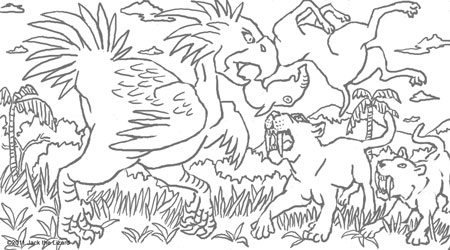
|
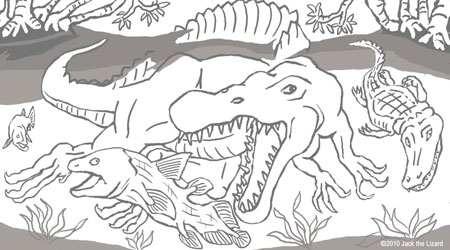
|
Flightless but Massive predator - Brontornis - Phorusrhacids were the group of flightless birds which lived in South America from about 65 million to 2 million years ago. Since their enormous size and predatory behavior, they are often called “Terror birds”. Brontornis Brumeisteri is the largest and Psilopterus Lemoinei is the smallest species in this family. Today all species of Phorusrhacids went extinct. Brontornis was about 3m (10 ft) tall and weighed approximately 500kg (1100lb). It was probably the dominant predator in Patagonia. Hunting style of Brontornis is not clear yet, but it could kill prey in ambush due to their stocky body. Macrauchenia would fall prey to Brontornis. |
The riddle of Spinosaurus Spinosaurus was probably good swimmer, because of the similarity between the skull of Spinosaurus and that of crocodiles. The staple food of Spinosaurus is unclear. They lived in near water and their teeth adapted to hold fish. So they probably depend on fish to survive, but some questions are still remaining. One of them is that fish is not sufficient to keep their enormous body about 16m (52ft) long and 5m (16ft) tall. Therefore they might feed on small dinosaurs or juvenile dinosaurs. The habitat of Spinosaurus was probably mangrove swamp in which large fish like coelacanth and crocodiles might be swimming around. |
|
For the print size image, click |

|
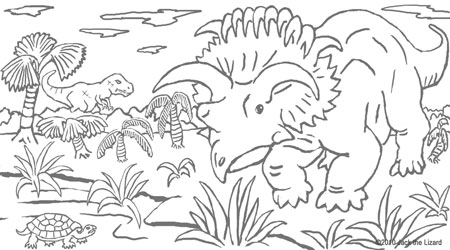
|
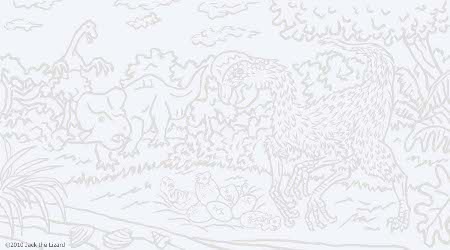
|
|
|
The Laramidia Dino - Kosmoceratops - Kosmoceratops is a new dinosaur. The name, kosomoceratops (kosomos means beauty or adornment in ancient Greek), is decided in 2010. Kosmoceratops lived in the lost continent Laramidia during the Late Cretaceous period about 76 million years ago. The fossils are discovered from the Kaiparowits Formation in Utah. Utahceratops is also a new ceratopsian dinosaur and found from the same formation. Furthermore the Kaiparowits Formation also included plant-eating dinosaurs such as Euoplocephalus and Parasaurolophus, and the carnivorous dinosaur, Albertosaurus. Kosmoceratops was approximately 5m (15ft) long and 2.5tons in weight. The feature is the frill with 10 horns. Kosmoceratops had 15 horns in total. Those horns might be used as defensive shields or the weapons against own species for domination. |
Eggs belong with me - Oviraptor - Ovi means egg. Raptor means bird of prey. What Oviraptor mainly had eaten is not yet to be known. But it is possible that Oviraptor took care of its eggs instead of stealing the eggs belonged to the other dinosaurs. The fossils of Oviraptor and their eggs are found in Mongolia. Protoceratops and Therizinosaurus lived during the late cretaceous period, same period of time as Oviraptor did in Mongolia. |

|
For the print size image, click |

|
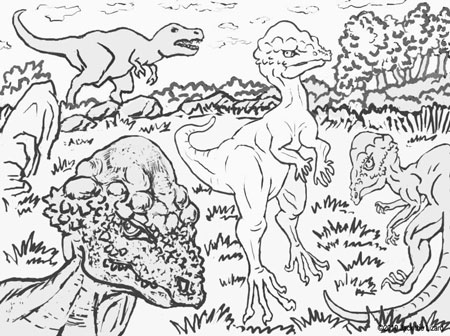
|
|
|
Los Angeles long long time ago - Columbian Mammoth - In North Africa the ancestor of Mammoths appeared about 5 million years ago. Then several kinds of Mammoths spread from Africa and covered continental Eurasia. Eventually they reached North America 1.8million years ago. Colombian Mammoths lived in North America about 1.3 million years ago and disappeared about 8000 years ago. The size is about 13ft (4m) tall and about 10 tons in weight. Incidentally the largest species of Mammoth is Songhua River Mammoth which was about 17ft (5m) tall and 17 tons in weight. They lived in Northern China about 280,000 years ago. |
Unique head - Prenocephale and Pachycephalo family - Prenocephale lived in the woodland of central Asia in which Mongolia is located now. The size was approximately 8ft (2.4m) long and 290lb (130kg) in weight. During the late Cretaceous period Prenocephale was probably browsing on plants and fruits. In those days Tarbosaurus, Asian Tyrannosaurus, was also walking around. Prenocepahle is a boneheaded dinosaur like Pachycephalosaurus and homalocepahle. The role of domed skull might be for head-butting as bighorn sheep do now. Recently known that the new boneheaded dinosaur called Texacephlae had bones of its skull endure the shock during the head on collision. |
|
For the print size image, click |

|
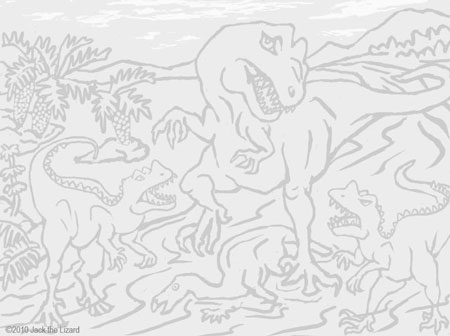
|
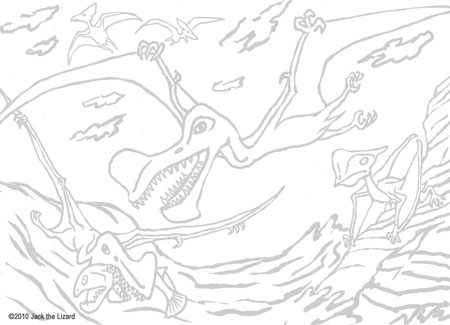
|
|
|
Ceratosaurus vs. Allosaurus Ceratosaurus and Allosaurus coexist in North America during the Late Jurassic Period, about 155 to 145 million years ago. Both of them are meat eater, but ceratosaurus may prey on fish and crocodiles. Since ceratosaurus had flexible body and crocodilian tail, it could be good at swimming. On the other hand allosaurus was much suitable for land because of its’ solid body and powerful arms. This difference also suggests that each of them lived in different types of environment. While ceratosaurus probably stayed in forest or closed to rivers, allosaurus seemed to prefer dry plain. When easy meal like the carcass of Camptosaurus came around, that is another story. |
Sky Ruler Anhanguera Anhanguera flew over Brazilian sky during the early Cretaceous period. The family of Anhanguera includes 5 to 6 species. Spread wing of the largest Anhanguera is about 7m. Anhannguera could have eaten fish such as Calamopleurus and Cladocyclus. Tapejara is anotother Cretaceous Pterosaurus. This toothless winged lizard is the oldest ptelosaurus ever found. Tapejara might eat fruits instead of fish. The wingspan is relatively short, about 1.5-1.8m. Two to three species are recognized as Tapejara family. Tapejata lived in Brazil and China. |

|
For the print size image, click |
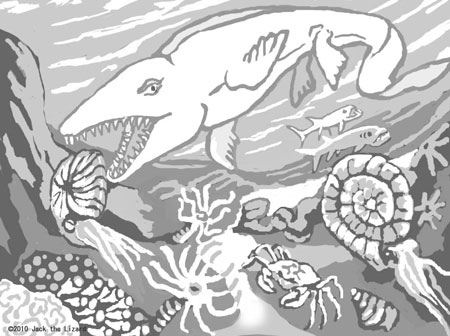
|
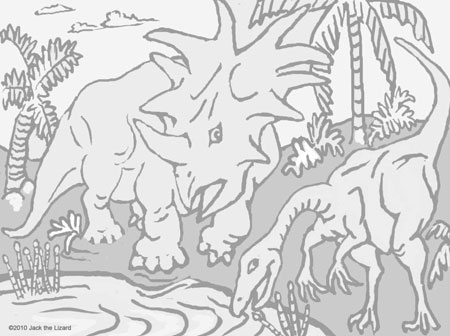
|
|
|
Mosasaurus days The family of mosasaurus includes several kinds of aquatic reptiles that have similar appearance. Clidastes is the smallest mosasaurus among them and Platecrpus is the most common mosasaurus in the U.S. Then Mosasaurus is one of the largest kinds. Mosasaurus lived during the late cretaceous period, around 70~65 million years ago. The first fossils were found in the Netherlands. So probably they were swimming in the sea of Western Europe. The length is about 15 m (50 ft) and the weight is about 15 tons. Tylosaurus and Hinosaurus are also large mosasaurus, but Mosasaurus has sturdier body than the others. Mosasaurus hunts fish, turtles, ammonite and small mosasaurus in shallow waters of sea. Since Mosasaurus was probably apex predator in those days, it could not be threatened by other animals in ocean. But juveniles were vulnerable to the attack by sharks and other predators. |
Rhinoceros and Ostrich? - Styracosaurus and Struthiomimus - During late cretaceous period around 75 million years ago Styracosaurus and Struthiomimus lived in North America. Both fossils were found in the Dinosaur Provincial Park which is located in southeast of Alberta, Canada. Styracosaurus belongs in the group of Ceratopsidae. The adult reached about 6 m (19.5 ft) in length and weighed about 3 tons. Presumably like the other Ceratopsidae the teeth of Styracosaurus were fitting to chop plants rather than grind. The food were probably palms, cycads or ferns. The dinosaurs relate to the group of Ornithomidae in which Struthiomimus also belongs look like Ostriches. They could run fast with long hind legs. Struthiomimus is about 3 to 4 m (10 to 14 ft) long and 1.4 m (4.6 ft) tall. Perhaps the diet composed of both pants and small animals. Are you interested in the fossils of Styracosaurus? Click HERE! |
|
For the print size image, click |

|
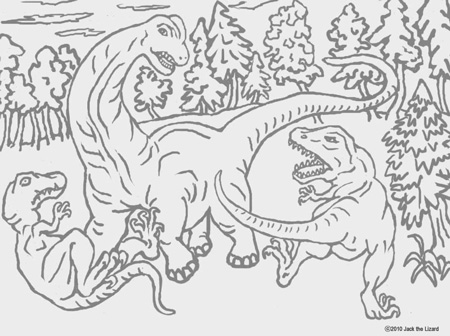
|
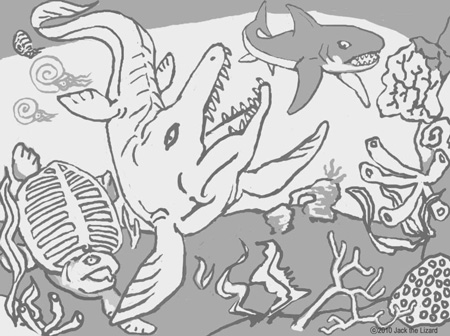
|
|
|
Battle of Argentina - Argentinosaurus and Mapusauru - Argentinosaurus lived in Argentina about 90 million years ago, during the middle cretaceous period. The size is one of the largest among the titanosaurs family in which Antarctosaurs, Andesaurus and other colossal sauropods dinosaurs are included. The length of Argentinosaurus is about 30 to 45 m (100~150 ft). The weight is about 100 tons. Like other sauropods dinosaurs, Argentinosaurus was probably plant-eater. Mapusaursu is about 13 m (42 ft) in length. This carnivorous dinosaur might do collaborative hunt with other Mapusaurus to take down sauropods dinosaurs. But mapusaurus only weighs about 9 tons, so it would not be easy. |
Gigantic marine lizard - Tylosaurus - Tylosaurus was a marine lizard that lived in the Western Interior Seaway during the Late cretaceous. The length was up to 14 m (45 ft). Tylosaurus probably did not have to watch for other predator once it matured. Tylosaurus pursued fish, sharks, plesiosaurs, small mosasaurs and even sea birds such as Hesperornis. Archelon was a sea turtle that also swimming in the same ocean. The size was about 4 m (13.5 ft). Archelon probably ate squids and other mollusks as some modern sea turtles do. |

|
For the print size image, click |
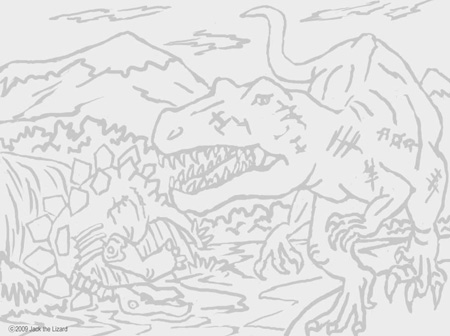
|
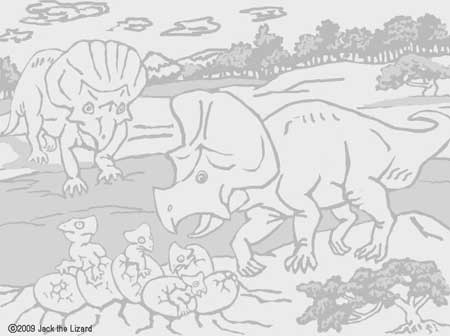
|
|
|
Allosaurus rhapsody Allosaurus probably could not run fast as tyrannosaurus did. But their arms were strong enough to hold prey and tear the flesh. Also developed neck muscle helps their jaws to bite meat off the bone. Allosaurus was the top predator in the Jurassic period. But the life of Allosaurus probably was not easy. They probably got injured from the counter attack of prey, fighting against each other or might compete with Ceratosaurus. |
Protoceratops family The fossils of Protoceratops have been found in Mongolia. These fossils include babies, juveniles, adults and eggs. The growth of frill can be observed by juxtaposing those different stages of fossils. Since so many of them have congregated, Protoceratops might live in herd and take care of eggs and young. Protoceratops was not large dinosaur, only 2 m (6.5 ft) long. On the other hand Triceratops which has also frill is about 9 m (30 ft). Both dinosaurs belong to the group called Ceratopsia. Although Psittacosaurus does not have frill but facial horns is also in same group. All Ceratposia dinosaurs has parrot-like beak and they are probably plant eater. |
|
For the print size image, click |

|
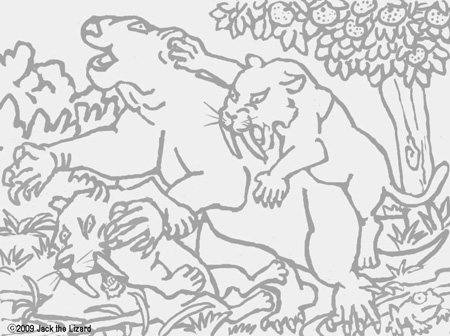
Another Smilodon coloring, click HERE!!
|
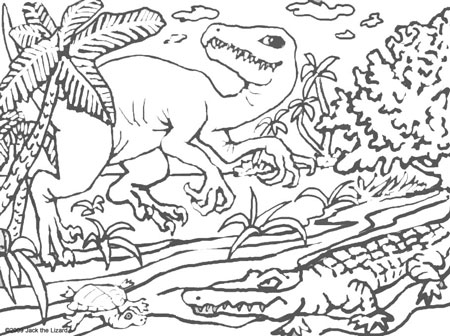
|
|
|
Smilodon A number of Smilodon fossils have been found in the La Brea tar pits in California with other mammal fossils such as mammoths, ground sloths, American bison and dire wolves. Smilodons might live in groups and hunt together. The preys are big mammals such as deer, bison and ground sloths. They might target on juvenile mastodon, too. The oldest and the smallest Smilodon species appeared 2.5 million years ago in the United States. Smilodon Populator lived in South America is the largest species in the Smilodon family. They are about 2 m (6.5 ft) long and 500 kg (1100 lb) in weight. All Smilodon species became extinct about 10,000 years ago. Lestodons lived in South America about 1 million years ago. They are giant ground sloths about 4 m (14 ft) long and 2.5 tons (5500 lb). In prairies or swamps they probably ate leaves, twigs and roots. More story about Smilodon and the Saber-toothed Cat is HERE! |
May be birds Deinonychus lived in North America during the early Cretaceous period, about 110 million years ago. The family of Dromaeosaurus including Deinonychus and Velociraptor is bird like dinosaurs. Deinonychus was meat eater with big eyes and claws, the size of which is about 3 m (11 ft) long. Goniopholis lived late Jurassic to early Cretaceous period in North America, Europe and Asia. The size is almost equivalent to modern crocodiles, about 2 to 4m (6.6 to 13 ft) long. The fossil of turtle has been found in China is the oldest one so far, about 220 years old. Pig-nosed turtle which lives in Australia and New Guinea is closely related to the fossilised turtle. |

|
For the print size image, click |
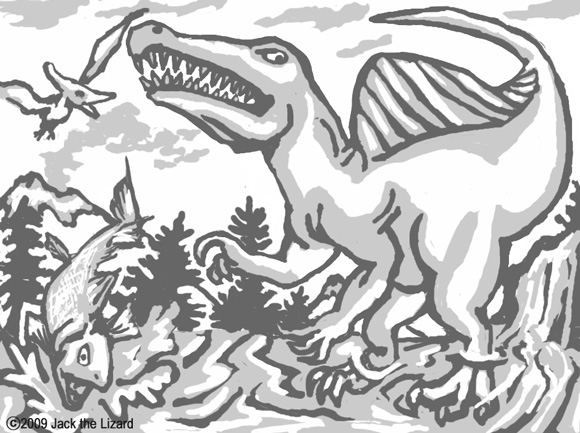
|
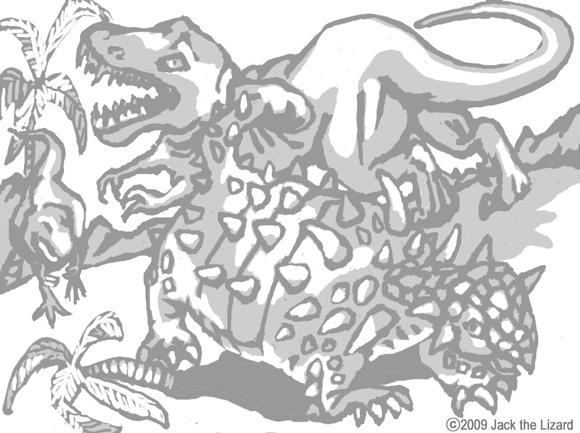
|
|
|
Spinosauridae There are several dinosaurs in the family of Spinosaurus. Angaturama and Irritator was about same size, 6~8 m (20~26 ft) in length and lived same period of time, around 110 million years ago. Both of their fossils were found in Brazil. Spinosaurus and Suchomimus probably had bigger body, about 11~17 m (36~56 ft) in length. Suchomimus lived in North Africa around 120 to 110 million years ago. Spinosaurus lived around 110 to 90 million years ago and the fossil was also found in Niger, Africa. All of the Spinosaurus family have long nose like crocodiles or gavials. Since they live in near rivers, lakes or sea, they probably eat fish often. A big fish like Mawsonia which is related to coelacanth, about 4 m (13 ft) long might be eaten by Spinosaurus. |
Euoplocephalus The fossils of Euoplocephalus have been unearthed in Alberta, Canada and Montana, U.S.A. Albertosaurus is very much like Tyrannosaurus except the body size about 9 m (30 ft) and build which is less stocky. Probably the speed is the weapon of Albertosaurus. On the other hand Euoplocephalus is an armored tank and likely cannot run away from fast Albertosaurus. But Euoplocephalus could move its tail quickly and counterattack against Albertosaurus. Albertosaurus perhaps needed some experience or help to flip over an adult Euoplocephalus. |
|
For the print size image, click |

|
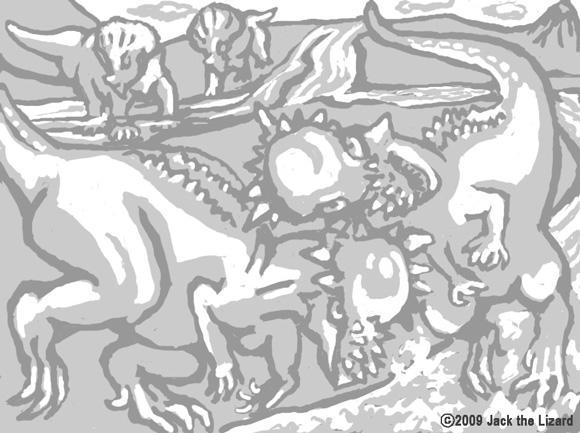
|
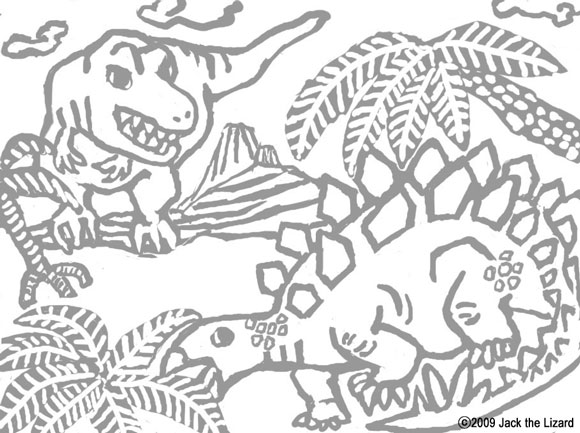
|
|
|
Pachycephalosaurus The skull of Pachycephalosaurus is about 25 cm (10 in). It is very thick!! There is only tiny space for the brain to fit in. Nobody knows why it is so thick for sure. It might be for the battle between males or the defence against enemies such as tyrannosaurus. The fossils of Montanoceratopus found in Montana as well as the ones of Pachycephalosaurus. Montanoceratops ate plants such as ferns, cycadas and conifers with its beak. Pachycephalosaurus probably ate plants too and might have eaten insects. |
Late Jurassic period extended from 160 million years ago to 145 million years ago. Allosaurus is Jurassic dinosaur. Serrated tooth and three fingers are signs of Allosaurus. Stegosaurus has distinctive plates and spines on its tail. The fossils of Stegosaurus have been found all over the world such as North America, China, India and Africa. Relatives of Allosaurus existed up to early cretaceous period (144 mya - 127 mya). On the other hand a few relatives of Stegosaurs survived till early cretaceous period. One of them is Wuerhosaurus. There are more stories and the sean where Stegosaurus exhisted. Click Prehistoric World !! |

|
For the print size image, click |
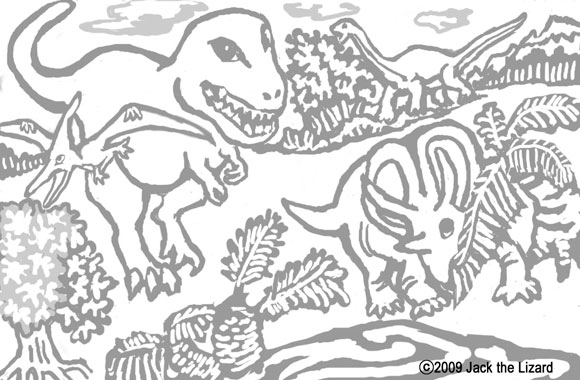
|
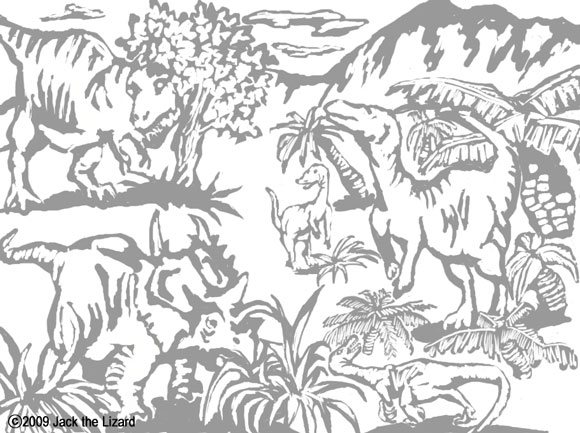
|
|
|
Tyrannosaurus has several relatives. Both Daspletosaurus and Tarbosaurus are closely related to Tyrannosaurus. The family of Tyrannosaurus has extremely small hands with two fingers. Also Titanosaurus has close relatives. Gigantesco Alamosaurus whose size is about 20 m (69 ft) in length is one of them. Antarctosaurus is even bigger, about 30 m (115 ft) in length, and has common relatives of Titanosaurus as well. Noticeable features of these kinds are a very long neck and a long whip like tail. This scene is probably somewhere in North America during late cretaceous period. Because all three dinosaurs, Tyrannosaurus, a Triceratops and an Alamosaurus, shared same land and time. Do you want to know more stories about T-rex? Click Prehistoric World. |
Einiosaurus lived during late Cretaceous period. The feature of Einiosaurus is the horn which bent forward. Maiasaura is a duck-billed dinosaur which belongs to a family of Hadrosaurus. The length of Dromaeosaurus is only about 1.8 m (6 ft)long. Despite of that Dromaeosaurus could run fast and had powerful jaws to crush bones of its prey. Ficus is a family to which fig trees belong. Tyrannosaurus is hiding behind the fig tree. |
|
For the print size image, click |
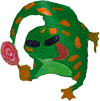
|
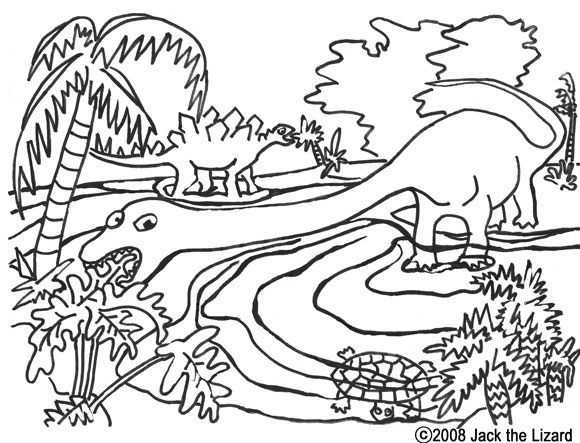
|
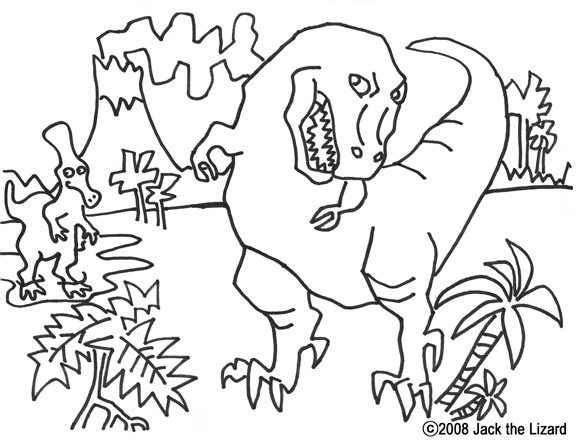
|
|
|
Apatosaurus and Stegosaurus |
T.Rex, Dinosaurs |